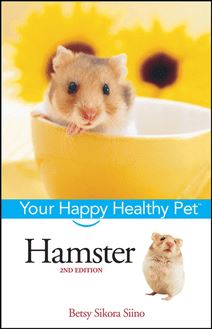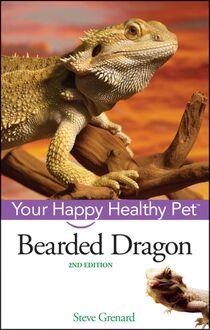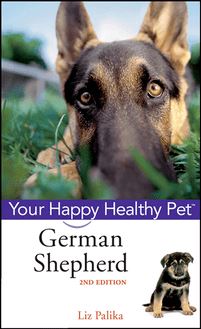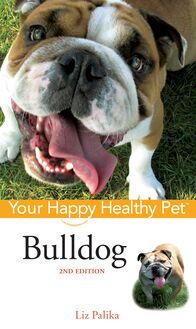-
 Univers
Univers
-
 Ebooks
Ebooks
-
 Livres audio
Livres audio
-
 Presse
Presse
-
 Podcasts
Podcasts
-
 BD
BD
-
 Documents
Documents
-
- Cours
- Révisions
- Ressources pédagogiques
- Sciences de l’éducation
- Manuels scolaires
- Langues
- Travaux de classe
- Annales de BEP
- Etudes supérieures
- Maternelle et primaire
- Fiches de lecture
- Orientation scolaire
- Méthodologie
- Corrigés de devoir
- Annales d’examens et concours
- Annales du bac
- Annales du brevet
- Rapports de stage
La lecture à portée de main
Vous pourrez modifier la taille du texte de cet ouvrage
Découvre YouScribe en t'inscrivant gratuitement
Je m'inscrisDécouvre YouScribe en t'inscrivant gratuitement
Je m'inscrisEn savoir plus
Vous pourrez modifier la taille du texte de cet ouvrage
En savoir plus

Description
* Expert authors, plus renowned guest contributors on specialized topics
* Full-color photos throughout
* Basic information on the breed, species, or topic
* Complete coverage of care, health, grooming, training, and more
* Tips and techniques to make life with a pet more rewarding
PART ONE: Welcome to the World of the Rottweiler.
1. What Is a Rottweiler?
2. The Rottweiler's Ancestry.
3. The World According to the Rottweiler.
PART TWO: Living with a Rottweiler.
4. Bringing Your Rottweiler Home.
5. Feeding Your Rottweiler.
6. Grooming Your Rottweiler.
7. Keeping Your Rottweiler Healthy.
PART THREE: Enjoying Your Dog.
8. Basic Training (Ian Dunbar, Ph.D., MRCVS).
9. Getting Active with Your Dog (Bardi McLennan).
10. Your Dog and Your Family (Bardi McLennan).
11. Your Dog and Your Community (Bardi McLennan).
PART FOUR: Beyond the Basics.
12. Recommended Reading.
13. Resources.
Sujets
Informations
| Publié par | Turner Publishing Company |
| Date de parution | 20 août 2007 |
| Nombre de lectures | 0 |
| EAN13 | 9780470252802 |
| Langue | English |
| Poids de l'ouvrage | 1 Mo |
Informations légales : prix de location à la page 0,0900€. Cette information est donnée uniquement à titre indicatif conformément à la législation en vigueur.
Extrait
The
Rottweiler
Howell Book House Hungry Minds, Inc. 909 Third Avenue New York, NY 10022 www.hungryminds.com
Copyright 1995, 2001 Howell Book House , a wholly owned subsidiary of Hungry Minds, Inc.
All rights reserved. No part of this book may be reproduced or transmitted in any form or by any means, electronic or mechanical, including photocopying, recording, or by an information storage and retrieval system, without permission in writing from the Publisher.
Howell Book House is a registered trademark of Hungry Minds, Inc.
For general information on Hungry Minds books in the U.S., please call our Consumer Customer Service department at 800-762-2974. In Canada, please call (800) 667-1115. For reseller information, including discounts and premium sales, please call our Reseller Customer Service department at 800-434-3422.
Library of Congress Cataloging-in-Publication Data
Forster, Jean. The Rottweiler: an owner s guide to happy, healthy pet/by Jean Forster. p.cm. Includes bibliographical references ISBN 0-87605-379-7 1. Rottweiler dog. I. Title. SF429.R7F67 1995, 2001 636.7 52-dc20 95-24282 CIP
Manufactured in the United States of America
14 13
Second Edition
Series Director: Kira Sexton Book Design: Michele Laseau Cover Design: Michael Freeland Photography Editor: Richard Fox Illustration: Jeff Yesh Photography:
Front cover photo by Jeannie Harrison/Close Encounters of the Furry Kind
Back cover photo by Ron Kimball Studio
Joan Balzarini: 96
Mary Bloom: 42 , 96 , 136 , 145
Paulette Braun/Pets by Paulette: 2-3 , 5 , 7 , 8 , 9 , 12 34-35 , 39 , 44 , 96
Buckinghamhill American Cocker Spaniels: 148
Sian Cox: 134
Dr. Ian Dunbar: 98 , 101 , 103 , 111 , 116-117 , 122 , 123 , 127
Jean Forster: 25 , 29
Shari Kathol: 27 , 46 , 47 , 48 , 58 , 60 , 62 , 67 , 94
Dan Lyons: 96
Cathy Merrithew: 129
Liz Palika: 133
Janice Raines: 132
Susan Rezy: 96-97
Judith Strom: 11 , 17 , 19 , 21 , 23 , 26 , 30 , 36 , 45 , 52 , 57 , 63 , 81 , 96 , 107 , 110 , 128 , 130 , 135 , 137 , 139 , 140 , 144 , 149 , 150
Page creation by: Hungry Minds Indianapolis Production Department
Contents
part one
Welcome to the World of the Rottweiler
1 What Is a Rottweiler?
2 The Rottweiler s Ancestry
3 The World According to the Rottweiler
part two
Living with a Rottweiler
4 Bringing Your Rottweiler Home
5 Feeding Your Rottweiler
6 Grooming Your Rottweiler
7 Keeping Your Rottweiler Healthy
part three
Enjoying Your Dog
8 Basic Training
by Ian Dunbar, Ph.D., MRCVS
9 Getting Active with Your Dog
by Bardi McLennan
10 Your Dog and Your Family
by Bardi McLennan
11 Your Dog and Your Community
by Bardi McLennan
part four
Beyond the Basics
12 Recommended Reading
13 Resources
chapter 1
What is a Rottweiler
Any definition of the Rottweiler would be incomplete without an explanation of the official standard of the breed. Each standard is prepared by the national breed club and approved by the American Kennel Club (AKC), the principal registry of purebred dogs in the United States. The standard provides a physical description of the breed with limited reference to temperament. The disqualifications noted in a standard are those things that prohibit the dog from competing with others of its breed for the required number of points necessary to be designated as a breed champion by the AKC. The serious faults noted prevent a dog from competing successfully. Reading a standard is dry and boring work; however, if you want a Rottweiler that really looks like a Rottweiler, you should familiarize yourself with what is and is not desirable.
Official Standard for the Rottweiler (Effective June 28, 1990)
General Appearance -The ideal Rottweiler is a medium large, robust and powerful dog, black with clearly defined rust markings. His compact and substantial build denotes great strength, agility and endurance. Dogs are characteristically more massive throughout with larger frame and heavier bone than bitches. Bitches are distinctly feminine but without weakness of substance or structure.
WHAT IS A BREED STANDARD?
A breed standard -a detailed description of an individual breed-is meant to portray the ideal specimen of that breed. This includes ideal structure, temperament, gait, type-all aspects of the dog. Because the standard describes an ideal specimen, it isn t based on any particular dog. It is a concept against which judges compare actual dogs and breeders strive to produce dogs. At a dog show, the dog that wins is the one that comes closest, in the judge s opinion, to the standard for its breed. Breed standards are written by the breed parent clubs, the national organizations formed to oversee the well-being of the breed. They are voted on and approved by the members of the parent clubs.
Size, Proportion, Substance Dogs- 24 inches to 27 inches. Bitches-22 inches to 25 inches, with preferred size being mid-range of each sex. Correct proportion is of primary importance, as long as size is within the standard s range. The length of body, from prosternum to the rearmost projection of the rump, is slightly longer than the height of the dog at the withers, the most desirable proportion of the height to length being 9 to 10. The Rottweiler is neither coarse nor shelly. Depth of chest is approximately fifty percent (50%) of the height of the dog. His bone and muscle mass must be sufficient to balance his frame, giving a compact and very powerful appearance. Serious Faults-Lack of proportion, undersized, oversized, reversal of sex characteristics (bitchy dogs, doggy bitches).
Head -Of medium length, broad between the ears; forehead line seen in profile is moderately arched; zygomatic arch and stop well developed with strong broad upper and lower jaws. The desired ratio of backskull to muzzle is 3 to 2. Forehead is preferred dry, however some wrinkling may occur when dog is alert. Expression is noble, alert, and self-assured. Eyes of medium size, almond shaped with well-fitting lids, moderately deep-set, neither protruding nor receding. The desired color is a uniform dark brown. Serious Faults-Yellow (bird of prey) eyes, eyes of different color or size, hairless eye rim. Disqualifications-Entropion, Ectropion. Ears of medium size, pendant, triangular in shape; when carried alertly the ears are level with the top of the skull and appear to broaden it. Ears are to be set well apart, hanging forward with the inner edge lying tightly against the head and terminating at approximately mid-cheek. Serious Faults-Improper carriage (creased, folded or held away from cheek/head). Muzzle -Bridge is straight, broad at base with slight tapering towards tip. The end of the muzzle is broad with well-developed chin. Nose is broad rather than round and always black. Lips-Always black; corners closed; inner mouth pigment is preferred dark. Serious Faults-Total lack of mouth pigment (pink mouth). Bite and Dentition-Teeth 42 in number (20 upper, 22 lower), strong, correctly placed, meeting in a scissors bite-lower incisors touching inside of upper incisors. Serious Faults-Level bite; any missing tooth. Disqualifications-Overshot, undershot (when incisors do not touch or mesh); wry mouth; two or more missing teeth.
Neck, Topline, Body. Neck-Powerful, well muscled, moderately long, slightly arched and without loose skin. Topline-The back is firm and level, extending in a straight line from behind the withers to the croup. The back remains horizontal to the ground while the dog is moving or standing. Body-The chest is roomy, broad and deep, reaching to elbow, with well pronounced forechest and well sprung, oval ribs. Back is straight and strong. Loin is short, deep and well muscled. Croup is broad, of medium length and only slightly sloping. Underline of a mature Rottweiler has a slight tuck-up. Males must have two normal testicles properly descended into the scrotum. Disqualifications-Unilateral cryptorchid or. cryptorchid males. Tail -Tail docked short, close to body, leaving one or two tail vertebrae. The set of the tail is more important than length. Properly set, it gives an impression of elongation of topline; carried slightly above horizontal when the dog is excited or moving.
The Rottweiler is a robust and powerful dog
Forequarters -Shoulder blade is long and well laid back. Upper arm equal in length to shoulder blade, set so elbows are well under body. Distance from withers to elbow and elbow to ground is equal. Legs are strongly developed with straight, heavy bone, not set close together. Pasterns are strong, springy and almost perpendicular to the ground. Feet are round, compact with well arched toes, turning neither in nor out. Pads are thick and hard. Nails short, strong and black. Dewclaws may be removed.
The Rottweiler s expression is noble and alert.
Hindquarters -Angulation of hindquarters balances that of forequarters. Upper thigh is fairly long, very broad and well muscled. Stifle joint is well turned. Lower thigh is long, broad and powerful, with extensive muscling leading into a strong hock joint. Rear pasterns are nearly perpendicular to the ground. Viewed from the rear, hind legs are straight, strong and wide enough apart to fit with a properly built body. Feet are somewhat longer than the front feet, turning neither in nor out, equally compact with well arched toes. Pads are thick and hard. Nails short, strong, and black. Dewclaws must be removed.
Coat -Outer coat is straight, coarse, dense, of medium length and lying flat. Undercoat should be present on neck and thighs, but the amount is influenced by climatic conditions. Undercoat should not show through outer coat. The coat is shortest on head, ears and legs, longest on breeching. The Rottweiler is to be exhibited in the natural condition with no trimming. Fault-Wavy coat. Serious Faults-Open, excessively short, or curly coat; total lack of undercoat; any trimming that alters the length of the natural coat. Disqualif
-
 Univers
Univers
-
 Ebooks
Ebooks
-
 Livres audio
Livres audio
-
 Presse
Presse
-
 Podcasts
Podcasts
-
 BD
BD
-
 Documents
Documents
-
Jeunesse
-
Littérature
-
Ressources professionnelles
-
Santé et bien-être
-
Savoirs
-
Education
-
Loisirs et hobbies
-
Art, musique et cinéma
-
Actualité et débat de société
-
Jeunesse
-
Littérature
-
Ressources professionnelles
-
Santé et bien-être
-
Savoirs
-
Education
-
Loisirs et hobbies
-
Art, musique et cinéma
-
Actualité et débat de société
-
Actualités
-
Lifestyle
-
Presse jeunesse
-
Presse professionnelle
-
Pratique
-
Presse sportive
-
Presse internationale
-
Culture & Médias
-
Action et Aventures
-
Science-fiction et Fantasy
-
Société
-
Jeunesse
-
Littérature
-
Ressources professionnelles
-
Santé et bien-être
-
Savoirs
-
Education
-
Loisirs et hobbies
-
Art, musique et cinéma
-
Actualité et débat de société
- Cours
- Révisions
- Ressources pédagogiques
- Sciences de l’éducation
- Manuels scolaires
- Langues
- Travaux de classe
- Annales de BEP
- Etudes supérieures
- Maternelle et primaire
- Fiches de lecture
- Orientation scolaire
- Méthodologie
- Corrigés de devoir
- Annales d’examens et concours
- Annales du bac
- Annales du brevet
- Rapports de stage




















